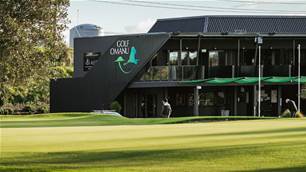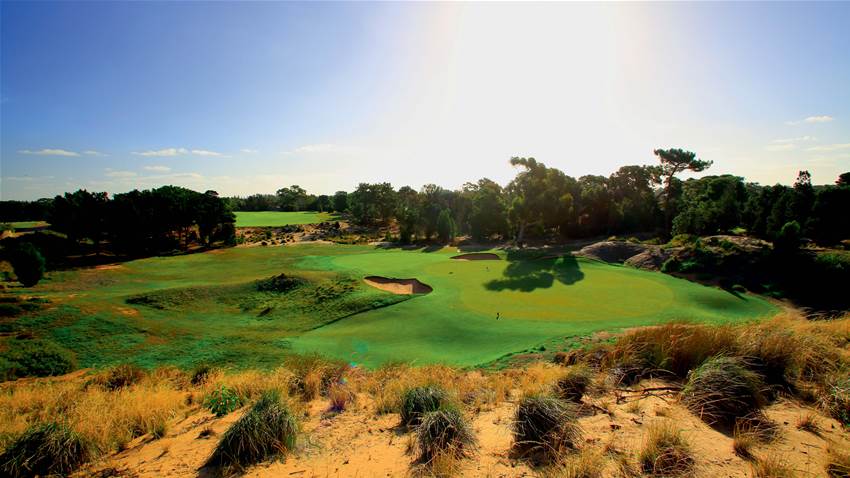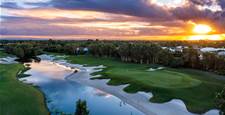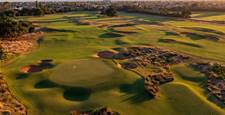It is often said “you are only ever 20 minutes from anywhere in the city of churches”. Here, we expand that perimeter to showcase the Top-12 Courses you will find within a 45-minute drive of Adelaide’s city centre.
1 ROYAL ADELAIDE GOLF CLUB
Royal Adelaide’s finish at No.1 here is confirmation of the long-held view that the Seaton links is the South Australian capital’s premier course.
There have been plenty of alterations made to the layout since the course originally opened for play in 1906, but it has retained its distinctive character of being an open links course, which is a rare find in Australia.
The host for nine Australian Opens and, more recently, the 2017 Women’s Australian Open is still undergoing some design changes under the guidance of minimalist American course architect Tom Doak. His changes – which have included altering some fairway mowing lines, clearing some overgrown areas of trees and scrub and the refurbishment of some bunkering – while seemingly small, have had a great effect on the quality of the layout and the golfing experience it offers. Doak’s remodelling work has been carried out using plans submitted by Dr Alister MacKenzie during his Australian visit in 1926 as a reference.
Even the iconic short par-4 3rd hole has been tweaked with more room created to the left of the sharp dogleg right fairway. The 266-metre two-shotter is part of the Doctor’s design and, although these days it is far more easily reached from the tee by longer hitters, it remains one of Australia’s best short par-4s. The drive is blind over the crest of a hill to a fairway that is now slightly wider between rough left and a high grass-covered sand dune to the right. The green is an odd shape and has been referred to as resembling a “leg of mutton”, which is fairly accurate. The green lies between a small ridge on its edge to the left and a knoll to the right. The beauty of this hole is that if you are brave, and long enough, to go for the green from the tee, you can make anything from an eagle two to a double or triple bogey.
The design changes aside, the quality of Royal Adelaide’s playing surfaces continues to improve year-on-year and it is now clearly one of the best-presented courses in the nation.
Green fees – $275 (non-affiliated Golf Australia members), $225 (affiliated players).

2 KOOYONGA GOLF CLUB
Kooyonga is a thinking player’s golf course.
One of the game’s greatest strategists during the past 70 years – as a player then course designer – was Peter Thomson. Having just won the 1972 Australian Open around the Adelaide layout, Thomson gave an insight into what was required to play well at Kooyonga.
“It needs to be played with the head as much as the hands,” Thomson said.
Originally created by Herbert ‘Cargie’ Rymill and opened for play in 1922, Kooyonga has been re-worked in recent times by the Golf Course Strategies design team of Neil Crafter and Paul Mogford.
Crafter, a lifelong member of the club, and Mogford reshaped some of the greens and cleared out the vegetation that was starting to encroach on the playing lines. As was seen during the Women’s Australian Open earlier this year, Kooyonga now offers several playing options on each hole with its wider avenues asking you to find the right position to make your approach into the greens.
It was these changes that enthused Golf Australia’s Top-100 judges and helped earn Kooyonga a spot at No.25 in the biennial ranking published in January this year.
Kooyonga packs plenty of punch for a layout that doesn’t cover a large parcel of land. The creative routing, variety of holes and outstanding presentation makes Kooyonga a ‘must play’ course for any golfer visiting Adelaide.
Green fees – $220 (Golflink card holders).
3 THE GRANGE GC (West course)
It’s a decade since designer Mike Clayton oversaw the replacement of all 18 greens, the reshaping of several fairways and the clearing of trees and scrub to open up the playing lines on many holes.
With more width available off the tee, there are questions asked of the golfer at almost every turn, which was clearly evident when the course hosted the Women’s Australian Open two years ago.
Heading into a round, the first of Clayton’s dramatic changes can be seen at the 423-metre par-4 3rd hole. Apart from being lengthened, the dogleg right fairway was opened up significantly by the removal of trees, which has exposed a spectacular sandy wasteland that was formerly used as a site for mining sand. A long bunker cuts into the right side of the driving zone but there is sufficient fairway to the left for the cautious hitter to find. A deep bunker short and left of the green ensures any player that skirts the right side fairway bunker is rewarded with a clear approach to the flag.
All of Clayton’s designs boast a quality short par-4 and here he actually shortened an existing par-4, the 7th, to create a more memorable hole. With the green lying 285 metres from the tee, some players have a real chance of reaching the green with their drive in the right wind conditions. For those players who lay back with an iron from the tee, the pin position will dictate the best side of the fairway to approach the green from.
Green fees – $200 (manager introduced), $75 (members’ guest).

4 GLENELG GOLF CLUB
Glenelg Golf Club was ranked No.30 in Australia’s Top-100 Courses earlier this year – and for good reason, too.
The outstanding conditioning of its couch fairways and bentgrass greens compliment the challenging par-71 track, which rewards precision over power.
Like any good golf course, Glenelg offers multiple playing lines from the tee, which could see every member of your group selecting different clubs. Again, accuracy is a necessity around this layout, with 90 well-placed bunkers eager to swallow anything slightly offline.
The par-3s at Glenelg are a real highlight. Each offer a unique and exciting test and will have players reaching for all manner of clubs. The 166-metre 11th is the toughest of the one-shotters, playing uphill and into the prevailing wind, but it is also one of the best holes on the course.
Another highlight at Glenelg is the maintenance of the rough surrounding its bunkers. The grass is cut to a length that keeps to the original design of the course, allowing the bunkers to come into play as they were intended.
The 12th hole is a very gettable 459-metre par-5 and is ranked 18 on the card.
Take a moment here to appreciate the entire property from highest point of the Adelaide plains.
Green fees – $190 (manager introduced), $80 (members’ guest).

5 THE GRANGE GOLF CLUB (East course)
Greg Norman was commissioned to redesign this original Vern Morcom creation in 2012, nearly 36 years after winning his first professional tournament around the layout.
Norman’s redo of the East course represented a $3 million exercise and allowed the club to achieve two key goals. One was to replace the greens, many of which were still original surfaces, and the other involved incorporating a Wetland and Aquifer Storage and Recovery Scheme, a first in Australia. Covering the eastern edge of the East course, this feature secured the club’s future water supply but required sensitive and sensible incorporation within the layout. Norman’s team pulled it off with aplomb, actually adding holes in the process. Space that initially housed just two holes morphed into three, a short and middle-distance par-4 at the 4th and 6th with a long par-3 nestled in between.
The par-3 5th is a beauty. Measuring 155 metres, the green is a classic ‘Redan’ that sits diagonally from right-to-left to your approach, and slopes from front to back. All the left side pin positions here are guarded by two deep bunkers, while a false front to the green can complicate getting up-and-down if your tee shot falls short.
Green fees – $200 (manager introduced), $75 (members’ guest).
6 TEA TREE GULLY GOLF CLUB
Set in the foothills of the Adelaide Hills, Tea Tree Gully has evolved from a nine-hole scrapes course in the early 1950s to a challenging par-71 that now ranks among Adelaide’s finest layouts.
A host of designers including Sloan Morpeth (Commonwealth GC, Melbourne) as well as Kel Nagle and Mike Cooper (Forster Tuncurry GC) have played a role over the years in the creation of the layout that can be played today.
Tea Tree Gully is a tight layout where you have to drive the ball straight and ensure your misses are in the right spots or you will be penalised harshly.
One hole where it pays to be straight, with the right club in your hand, is the short 7th hole – a dogleg left par-4 of 338 metres with four large bunkers squeezing the edges of the fairway at the turn. The fairway also features a slight right-to-left camber that can see balls roll into the furthest of the left traps. A large bunker short right of the putting surface is best avoided.
Green fees – Tee times are available for visitors. Green fees – $35.

7 THE VINES GOLF CLUB OF REYNELLA
The Vines Golf Club of Reynella began as the Marino Golf Club in 1925 before moving from the city to the Adelaide Hills in the early 1960s.
While the location chosen among native bush reserves was seen as ideal to build the course, it lacked the most valuable resource of all, water. Five dams have been built and water harvesting introduced in a series of major projects over the past 30 years, all of which provides 100 megalitres of irrigation to support the course’s very good playing surfaces.
The Santa Ana fairways are terrific to hit off, while the pure bentgrass greens are generally regarded as some of the best you will find outside Adelaide’s Sandbelt.
While the conditioning will impress, you will also enjoy the quality of the challenge. The Vines’ collection of par-3s is memorable with the first of them, the 149-metre par-3 3rd hole, featuring beautiful 100-year-plus red gums surrounding the green. The canopy of the surrounding trees does come into play if you venture off line with your tee shot so accuracy is vital here.
The two back nine par-3s both play to elevated greens. The 145-metre 10th leads away from the clubhouse to a green where most of the front edge is guarded by a cavernous bunker. Club selection here is important as out-of-bounds is directly behind the green, so trying to avoid the bunker with a longer club could prove troublesome.
The shortest of the one-shotters is the uphill 14th. At 129-metres, it’s not a hole where length is the concern but with two bunkers either side of the entrance into the relatively small putting surface, it still pays to be straight.
Green fees – Tee times are available for visitors. Green fees – $45.

8 WEST LAKES GOLF CLUB
With famous neighbours like Royal Adelaide and The Grange, it is not surprising that West Lakes Golf Club is the hidden gem of the Adelaide Sandbelt – at least to golfers outside the South Australian capital.
West Lakes, formerly Riverside Golf Club, has undergone significant changes over the past few years including a name change in 2011, clubhouse renovations and extensive course improvements.
This Neil Crafter and Paul Mogford-designed course is now one of the most enjoyable layouts to be found in Adelaide’s suburbs.
West Lakes is short by modern standards – measuring 5,636 metres – but the par-70 layout is challenging, and by no means a pushover. The tree-lined fairways are well manicured and are predominantly covered with couch grass as the club continues with a program to eradicate the existing kikuyu.
One of the real upsides to West Lakes is its routing. Three points of the compass are covered within the first quartet of holes, eliminating the predictability of wind direction, while each of the opening three holes offer variety by playing to different pars.
The large, modern clubhouse occupies a prime position – overlooking the tees of the 1st and 10th holes, as well as the 18th green – and its natural location attracts a plethora of wildlife.
The par-5 1st hole is 17th on the stroke index and does exactly as it should, easing you into your round at 455 metres and offering an early scoring opportunity.
The green complexes are relatively flat, but they are beautifully maintained with true, bentgrass surfaces and trimmed collars.
Green fees – $40 (member’s guest).

9 MT OSMOND GOLF CLUB
Mt Osmond is one of the oldest in the Adelaide Hills having been formed in 1927. With Edward Holden – founder of Holden cars – at the helm as the inaugural club president, Mt Osmond established a reputation among Adelaide society as the perfect weekend getaway to a country club.
Today, Mt Osmond is a well-manicured challenge having been extensively redesigned by Tony Cashmore, who has created high ranking layouts like Thirteenth Beach and the Henley course at The Heritage in Melbourne. The reconstruction of the course was completed in 1997, with large rolling putting surfaces and visually imposing bunkering elevating the test and enjoyment on offer.
Mt Osmond, by nature of its location, mixes holes with dramatic elevation changes with several easier walking holes that have been terraced into the edge of the sloping terrain.
The trio of holes that complete the front nine are memorable for their visual appeal as well as the challenge they present. The 275-metre par-4 7th holds no surprises as the tee sits high above the wide fairway. But be wary of the two bunkers left and right of the slight dogleg left that are difficult to escape from and ensure a bogey is a good score.
The 7th hole plays alongside one side of a massive water storage dam, while the 8th hole leads you back in the opposite direction, doglegging to the right passed the edge of the same water hazard. The hole plays longer than the 342 metres on the scorecard by virtue of the steady climb to the green, which is angled slightly front left to back right. Three bunkers – two short left and right and a sneaky pot bunker back left – combine with mounds and hollows to place a premium on hitting a straight approach to avoid a difficult up-and-down to save par. It’s easier said than done too, as the fairway cambers down toward the storage dam leaving a right hander with a shot where the ball lies below the feet.
The 8th hole is index No.5 on the Mt Osmond scorecard, while the front half rounds out with the fourth most difficult. At 359 metres from the tips, the par-4 9th hole is a narrow driving hole but any complications you have en route to the green are all but forgotten as you stand on the huge putting surface and as you soak in the view of Adelaide and the ocean beyond. It is one of the finest panoramic views you will experience in South Australia.
Green fees – $55 (weekdays), $60 (weekends).
10 THAXTED PARK GOLF CLUB
Thaxted Park’s first few decades after opening in 1964 were a constant battle for water. But four on course dams and an agreement with the local council provides enough water these days to ensure the playing surfaces are first class.
All the fairways have been gradually been converted to Santa Ana couch, which thrives in this area. The bentgrass greens are also very good. The standard of presentation is being complimented by an improved layout with the redevelopment of the front nine.
Course architects Neil Crafter and Paul Mogford of Golf Strategies have come up with a masterplan for the course, which has predominantly involved widening fairways, creating new fairway bunkers, moving and remodelling greens as well as some tees.
The new holes have certainly raised the bar but one of Thaxted Park’s most picturesque and memorable holes comes late in the round. The 15th hole is a little more than 100 metres from the elevated tee down to the relatively small green that lies just beyond a creek bed. There is a bunker long of the green that comes into play more often than you might expect, while the real beauty of this hole is the amphitheatre setting of the green and the gum trees that surround it.
Green fees – $32 (weekdays); $37 (weekends).

11 BLACKWOOD GOLF CLUB
The Vern Morcom-designed Blackwood course covers wonderful undulating terrain in the Adelaide Hills.
Opened for play on the current site in 1963, Blackwood has undergone many changes from Morcom’s original work. Combined with the maturing over more than 50 years of hundreds of trees, Blackwood has evolved into a tight driving layout where a premium is placed on accuracy.
The rolling landscape combines well with the heavily tree-lined fairways to provide a picturesque setting for an enjoyable and challenging round.
Green fees – $40.

12 ADELAIDE SHORES (Patawalonga Course)
The Patawalonga Course at Adelaide Shores has gone from strength to strength since being redesigned by Neil Crafter and Paul Mogford and has hosted the last seven SA PGA Seniors Championships.
From the well-manicured kikuyu fairways and massive bentgrass greens – averaging 750 square metres – to the beautiful red sand found in each of its bunkers, Patawalonga is a joy to play for any level of player.
Its four par-3s are perhaps the most memorable and enjoyable aspect; the longest of which (No.12) measures 167 metres from the tips.
The par-72 layout stretches to 5,913 metres. But it can play much longer, depending on the direction of the coastal winds.
Green fees – $29 (weekdays); $38 (weekends).
HOW TO GET THERE
FOUR REDS GOLF
Four Reds is a golfing experience that plays to South Australia’s strengths. It pairs four exceptional golf courses with four exquisite wines to create one memorable holiday.
Visitors enjoy three to six nights based in Adelaide, the capital of South Australia. This vibrant, wealthy city of 1.2 million enjoys a Mediterranean climate and abundant scenery, with beaches on one side and hills on the other.
A prime golfing destination, Adelaide is home to four very fine courses of long-standing repute – courses that are less famous than their eastern state counterparts, but no less challenging, perhaps more accessible and certainly a surprise to those who have not played them before.

South Australia is also a wine-making heartland, producing half of the nation’s wines and home to the world-famous Barossa Valley. It’s responsible for some of the most prestigious vintages ever to grace a table.
Which leads to a very natural pairing...
The Four Reds comprise Glenelg, Grange, Kooyonga and Royal Adelaide, offering a perfect mix of prestige, challenge, scenery and good old fashioned Australian hospitality.
After visitors complete each Four Reds golf course, they are invited to round off their day with a tasting plate of local gourmet produce and a bragging-rights bottle of first class wine.
If a guest’s passion for fine wine rivals their enthusiasm for golf, Four Reds can keep the celebrations flowing with exclusive winery tours of the Barossa Valley.
Four Reds tours and packages are arranged exclusively by Adelaide-based golf holiday specialist, Golf Explorer.
Four Reds offers six holiday packages ranging from three to six nights in Adelaide, including all course fees, transfers, accommodation and paired wine experiences.
Any package can be tailored to suit you One popular package is the ‘Four Reds 72-Hole Challenge’, which includes five nights’ accommodation at the Stamford Plaza (double occupancy), daily breakfasts, private transfers, four rounds of golf with a round at each of the Four Reds clubs, each paired with premium wines and seasonal tasting plate. The cost of this package starts from $1,735 per person (based on four people travelling)
For more information or to book your tailor made Four Reds golfing holiday in Adelaide, visit the website http://www.fourreds.com.au/
Related Articles

Review: Omaha Beach Golf Club

Drinks With... Ricky Ponting













